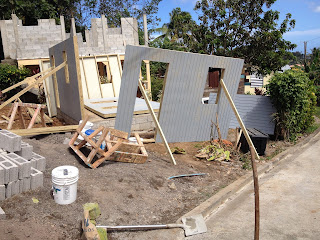I've always dabbled in art, and especially graphic arts. I made a lot of posters for student government during college. For my legislative and school board campaigns, I designed my own logo, brochures, advertisements, etc. During my federal career, I won several poster awards. I don't claim to be an expert (as I stated in this previous story), but it's just something that I enjoy doing.
Many of you know about my life-long involvement with auto racing. When I was young, I was fascinated with how the paint jobs, lettering, and number fonts could give “personalities” to the different cars. I figured out how the sign painters could use a flat brush to make the thick and thin strokes used in fancy lettering. That made it easy for me to quickly pick up on calligraphy when I got my first fountain pen.
I had not foreseen it, but these graphic arts skills are proving useful in my school as well as the community. I recently provided some much needed signage identifying our village by painting the side of the bus stop along the main road (shown below). I've written previous stories that mentioned other projects, including the big sign for our village feast and the beautiful new marching banner for our school, inspired by the design elements of the Dominican flag.
I am often asked by teachers to create signs for their classrooms. Usually they have an idea of what they want to convey, and I just draw it up for them freehand, rarely using a ruler or anything. With many of these posters, in America I would have used different color combinations, but we are limited here to what cardboard scraps (called Bristol board here) and markers are available. Below is a portfolio of some of my recent work (with comments underneath each photo). CFS stands for Child Friendly Schools. It is hard to see, but there are some subtle shading differences on the various sides of the "engraved" lettering. This poster is a huge one that the teacher will put spelling words as leaves on the “word tree.” That is the “Cat in the Hat” drawn underneath the tree, with butterflies, birds, clouds, and other small details she suggested. I enjoyed trying to remember how a digital clock's numbers look when I made this (there is a slight error on the bottom left corner of the “2,” but I doubt any of the students pick up on it). I like the tangled vines on this one, helping to separate the different ecosystem types. You can also see in the top left corner the bottom of a cloud-shaped “Science Corner” sign—several classrooms have multiple “subject corner” signs. For some variety, I used something like a gothic script on this one, designed to show off student papers. Rather than one large poster, this is a small central rectangle surrounded with multiple groupings taped to the wall. It is a way to utilize smaller pieces of Bristol board. Some of my former college students could have benefited from this poster! However, I messed up the original version when I colored the stoplight just as it would be in America, with the red light on the top. Unfortunately, that doesn't work with the concept they are trying to teach. A sharp knife let us flip the red and green lights around. Notice in these two posters that periods are called “full stops” down here. With that, I'll come to a full stop on this short story.
Since this post is so brief, I thought I'd add a reminder that my blog readers could do a great service for my little village if you would make a tax-deductible donation to the “Courts For Kids” project. Our first ever basketball/netball court will be built this summer, thanks to the partial grant I won. However, the more money I can get my friends to donate, fewer dollars will need to be raised from the local residents here (who don't have all that much disposable income). Just go to http://courtsforkids.org/donate/, choose “Donations toward host-country partner,” and indicate in the comments section that this is for the Dominica project. We would be extremely grateful for anything you can share with us! Thank you in advance for your assistance!






























































